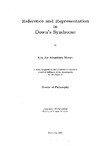Reference and Representation in Down's Syndrome
| dc.contributor.author | Kingsbury Moore, Lois Joy | |
| dc.contributor.other | ||
| dc.contributor.other | School of Psychology | en_US |
| dc.date.accessioned | 2013-11-01T10:53:04Z | |
| dc.date.available | 2013-11-01T10:53:04Z | |
| dc.date.issued | 1996 | |
| dc.identifier | NOT AVAILABLE | en_US |
| dc.identifier.uri | http://hdl.handle.net/10026.1/2522 | |
| dc.description | Merged with duplicate record 10026.1/1290 on 10.04.2017 by CS (TIS) | |
| dc.description | Merged with duplicate record 10026.1/1290 Submitted by Collection Services (collectionservices@plymouth.ac.uk) on 2013-02-11T09:11:56Z No. of bitstreams: 1 1996MoorePHD.pdf: 49481100 bytes, checksum: b3d3efc37826e75b5d5bd1ec2683cc99 (MD5) Approved for entry into archive by Collection Services(collectionservices@plymouth.ac.uk) on 2013-02-11T09:17:59Z (GMT) No. of bitstreams: 1 1996MoorePHD.pdf: 49481100 bytes, checksum: b3d3efc37826e75b5d5bd1ec2683cc99 (MD5) Made available in DSpace on 2013-02-11T09:17:59Z (GMT). No. of bitstreams: 1 1996MoorePHD.pdf: 49481100 bytes, checksum: b3d3efc37826e75b5d5bd1ec2683cc99 (MD5) Previous issue date: 1996-12 | |
| dc.description.abstract |
Previous research has highlighted a different pattern in the use of grammatical forms to successfully maintain coherent discourse by individuals with Down's syndrome. To maintain coherent discourse both linguistic and non-linguistic information must be integrated and maintained in a mental representation of current discourse. The ability of children with Down's syndrome to use such a mental representation has been assessed in this study. The ability of adults with Down's syndrome to comprehend and produce a range of grammatical forms was initially assessed, using a grammaticality judgement task, an imitation task, and a spontaneous speech sample. Results indicated that the production and comprehension of pronouns was found moderately difficult. The successful use of a pronoun depends on the ability to use a mental representation to retain information about its antecedent in order to assist correct interpretation and avoid ambiguity. A narrative task was used to investigate the use of referential forms by children with Down's syndrome and typically developing children. The effects of certain contextual features on the use of referential forms were investigated: the status of each character and the number of characters in the story; the method of presenting the story; and the position of a listener while the story was narrated. When narrating a story typically developing children distinguished the status of characters in the stories by consistently using different referential forms for each. As age increased this strategy was used more successfully and flexibly. Children with Down's syndrome did not use referential forms in the same way as typically developing children. It is likely that this is a consequence of a difficulty in maintaining information about the whole story-where many sources of information must be accessed, integrated and maintained in a mental representation. At a local level within the story, children with Down's syndrome used referential strategies successfully, demonstrating an ability to integrate limited amounts of information about characters in a story. The inability to maintain information in a mental representation across longer periods of discourse indicates the importance of short term memory in language production. | en_US |
| dc.language.iso | en | en_US |
| dc.publisher | University of Plymouth | en_US |
| dc.title | Reference and Representation in Down's Syndrome | en_US |
| dc.type | Thesis | |
| plymouth.version | Full version: final and full version as approved by the examiners at the time of the award of your degree | en_US |
| dc.identifier.doi | http://dx.doi.org/10.24382/3712 | |
| dc.identifier.doi | http://dx.doi.org/10.24382/3712 |
Files in this item
This item appears in the following Collection(s)
-
01 Research Theses Main Collection
Research Theses Main


